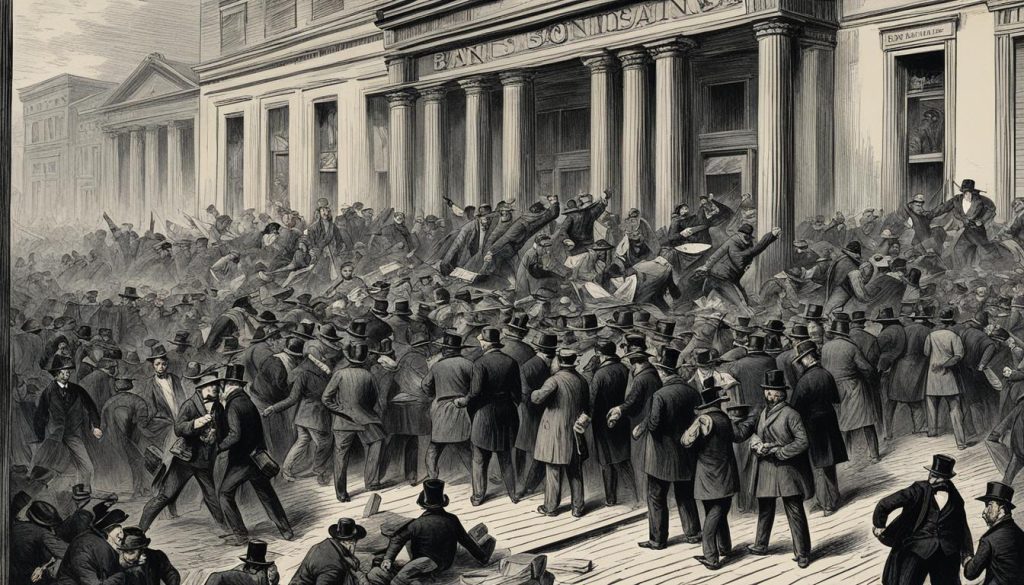As we unravel the complex tapestry of American financial history, the Panic of 1873 stands out as a significant economic depression that signaled the fragility of post-war prosperity. This financial crisis plunged the United States into turmoil, with far-reaching consequences that affected the fabric of society. Here we delve into the causes of one of the biggest fincial crises in history, exploring how global financial currents and domestic policy led to a collapse that resonated throughout history.
The Prelude to Crisis: Economic Expansion after the Civil War
At the heart of the post-Civil War prosperity lay the railroad industry, a symbol of progress and the driving force behind an era of aggressive economic expansion. With the war’s end came the rush towards a bright industrial future, ushering in a time where the steam locomotive became king and its tracks the new veins of American commerce.
Fueling the hunger for growth were the slew of European investments, seduced by the siren call of potential profits in a burgeoning America. Banks, flush with capital, poured their resources into railroads, certain of their ability to knit together a country in dire need of connection and stimulate economies from coast to coast. Yet, beneath this gleaming surface of prosperity, the seeds of an inevitable downturn were sown. This period did not simply set the stage for the coming post-Civil War recession but for a global economic impact that would resonate across countries and oceans.
Booming Railroad Industry and Investment Surge
The statistics were staggering: 35,000 miles of track laid down in just seven years, creating not just a web of steel across the nation but also making the railroad industry the largest non-agricultural employer. This was more than growth; it was a transformative period, reshaping how Americans moved, worked, and lived. But as the tracks spread ever outward, the economic soil from which they sprung began to fracture under the weight of speculative practices and overinvestment, heralding the looming railroad industry collapse.
European Investments in American Ventures
From across the Atlantic, European capital flowed into the United States, enticed by the lure of quick returns and the promise of a part in building the New World. Major infrastructural projects, upon which the American dream was being built, were backed by foreign wealth, seeking the warm embrace of a market that seemed infinite in its possibilities. Yet, as subsequent events would show, these vast sums of money propelled the American economy towards unsustainable heights, culminating in a painful correction that underscored the global economic impact of the nation’s financial woes.
The interwoven narratives of technological triumph and financial exuberance painted a complex picture of an America standing on the precipice of change. A change that would test the resilience of its economy and the foresight of its investors, as the country edged closer to the edge of the economic abyss that would become known as the Panic of 1873.
Financial Dominoes: The Collapse of Jay Cooke & Company
On a fateful day known as Black Friday 1873, a significant player in the American financial market met its downfall. Jay Cooke & Company, a bank that had once been the backbone of war-time financing and an architect of post-war economic expansion, found itself overpowered by the very industry it had helped to flourish. Railroad investments, once the symbol of progress and prosperity, had become the bank’s Achilles’ heel. With the fall of this institution, the economic stability of the United States was called into question, leading to cascading effects across the nation.
The financial landscape of the time was a precarious house of cards, with Jay Cooke & Company’s failure acting as the gust of wind that toppled it. This event was the spark that ignited the widespread financial panic that swept across the country. Banks and businesses alike were caught in the storm of bank runs and credit crunches, as confidence in the American financial system wavered. The following outline encapsulates the series of events that led to the wide-reaching consequences of the firm’s collapse:
- Overextension in Railroad Financing – The Northern Pacific Railroad, a project heavily financed by Jay Cooke & Company, became a symbol of the speculative risks rampant in the industry.
- Bankruptcy Filing – The realization that the bank’s resources were stretched too thin led to the inevitable declaration of bankruptcy.
- Immediate Financial Aftermath – Banking institutions, businesses, and industries tied to the firm experienced a domino effect, leading to a slew of bankruptcies nationwide.
- Long-Term Economic Consequences – The failure of such a prominent firm eroded public trust in the banking system, contributing to a severe and prolonged economic depression.
In exploring the detailed outcomes that followed the collapse, one can see the far-reaching implications of the crisis:
| Event | Immediate Impact | Long-Term Consequence |
|---|---|---|
| Collapse of Jay Cooke & Company | Public Panic and Runs on Banks | Widespread Financial Insecurity |
| Bankruptcy of Railroads | Unemployment and Economic Stagnation | Decrease in American Industrial Expansion |
| Bank Failures | Loss of Savings and Investment Capital | Skepticism towards Financial Institutions |
| Market Volatility | Price Fluctuations and Commodity Uncertainty | Reevaluation of Market Practices |
The cautionary tale of Jay Cooke & Company serves as a historical reflection on the vulnerabilities of a speculative economy. It is a narrative that resonates through the ages, warning of the dangers of excessive risk in the shadow of prosperity.
The Panic of 1873: The Breakdown of Financial Institutions
The year 1873 marked a tumultuous period in the financial history of the United States as numerous banks succumbed to the pressures of a failing economy. This phenomenon not only triggered a loss of confidence in these institutions but also significantly contributed to a rise in unemployment rates, paving the way for a national crisis.
Nationwide Bank Failures and Panic
From coast to coast, the soundness of the banking sector faced severe scrutiny, with significant bank failures occurring in multiple states. This sudden collapse of trusted financial establishments led to a domino effect, shaking the foundation of the American economy.
Public Reaction and the Run on Banks
Fear and uncertainty gripped the nation as citizens, driven by the need to protect their savings, started withdrawing their deposits en masse. This course of action hastened the liquidity crisis and intensified the panic, further destabilizing an already fragile system.
| State | Number of Bank Failures | Unemployment Rate Increase |
|---|---|---|
| New York | 30 | 4% |
| Pennsylvania | 25 | 5% |
| Ohio | 15 | 3% |
| Illinois | 10 | 4.5% |
| Virginia | 8 | 3.2% |
The repercussions of this financial catastrophe were profoundly felt across the country, displacing workers and prompting a serious reevaluation of banking practices and economic policies. The legacy of the 1873 panic serves as a stark reminder of the interconnectedness of financial systems and the consequences that can arise from their failure.
Railroads: The Catalyst for Economic Meltdown
The latter half of the 19th century saw the railroad industry propel the American economy to new heights. However, it was the very same railroad expansion that precipitated one of the most significant economic downturns in the nation’s history. During the Panic of 1873, the railroad industry’s collapse had widespread repercussions, leaving an indelible mark on the financial landscape of the era. This period highlights the complex interplay between industry ambitions and economic sustainability.
Railroad Overexpansion and Impact of Bankruptcy
In the rush to dominate the transportation sector, railroad companies embarked on ambitious projects that would soon outstrip actual demand. Speculative investments poured in, and the landscape of America was rapidly webbed with rail tracks. However, this overexpansion led to a dire outcome: a cascade of bankruptcies. With 89 railroad companies filing for bankruptcy, the implications were felt nationwide, affecting banks, businesses, and individual livelihoods, undeniably marking the railroad industry as a critical point of failure in what would become a prolonged depression.
Government Role in Railroad Financing
The U.S. government did not stand as a mere observer to the burgeoning railroad industry. Instead, through various means, such as land grants and substantial financial backing, the government played an integral role in fostering the growth of railroads. Despite the best intentions to stimulate economic development and expansion into new territories, the government’s support ultimately contributed to the industry’s overextension. It underscored the risks inherent in high-stakes investments within an already saturated market, laying bare the impact of such strategies when the economy turned south.
Key Points:
- Bold ambitions in railroad expansion aligned closely with the economic identity and growth of post-Civil War America.
- The government engaged actively in financing initiatives to support the railroad industry, becoming a significant stakeholder in its success—and its failures.
- The saturation of the railroad market became a glaring example of over-speculation, leading to fiscal consequences that rippled through the economy.
Widespread Impact: Business Collapses and Unemployment
The Panic of 1873 ushered in an era now known as the Long Depression, a period characterized by widespread economic depression and soaring unemployment rates. With the failure of 18,000 businesses over just two years, the economic fabric of the United States was deeply scarred. As the job market contracted, unemployment rates skyrocketed, reaching an unprecedented 14 percent by the year 1876. This was not merely a statistic but a reflection of the immense human toll the crisis exacted on American society.
The labor force, once the backbone of the country’s economic might, now faced wage cuts and diminishing opportunities. Unemployment wasn’t the only specter haunting American workers; those who managed to keep their jobs grappled with reduced income and hostile working conditions. The ripple effect of these tumultuous changes was profound, leading to widespread dissatisfaction that often manifested in strikes and social unrest. Below, we outline the most significant manifestations of this economic upheaval:
- Business Failures: A cascade of bankrupt businesses, culminating in a significantly altered corporate landscape.
- Workforce Impact: Mounting job losses, wage reductions, and a general sense of insecurity within the labor market.
- Social Consequences: Heightened social tensions and protests as workers sought to voice their opposition to the deteriorating conditions.
What began as a financial crisis soon evolved into a broader socio-economic challenge that reshaped life in the 1870s. The economic depression spanned over half a decade, making it an unrelenting force in the lives of business owners, workers, and families alike. As history looks back at this difficult chapter, the emphasis falls not only on the financial losses but also on the indelible mark it left on the American workforce and the relentless spirit that emerged in its wake.
The Social Struggles: Workers, Strikes, and Social Movements
The decade following the Panic of 1873 was marked not only by economic hardship but also by heightened social tensions that manifested in the labor force. As factories and railroads reduced wages and extended hours to combat their financial losses, the response from workers was swift and fervent. This period saw a surge in labor strikes, which became a defining feature of the social turmoil of the times.
Response to Wage Cuts and Poor Working Conditions
As unemployment rates soared and those with jobs faced significant wage cuts and poor working conditions, the American working class reached its breaking point. What started as isolated incidents of work stoppages soon escalated into organized labor strikes. These strikes were the workers’ outcry against the injustice they faced and their attempt to fight for fair compensation and humane working environments. The railroad strikes of 1877, in particular, were a powerful display of unity and resistance against corporate exploitation.
Rise of Socialist Influence in Urban Centers
In the wake of persistent economic struggles, socialist ideas began to take hold, particularly in densely populated urban centers like Chicago. The labor unrest exposed the growing dissatisfaction with the capitalist industrial system, and social movements began to advocate for more equitable economic structures. This period became fertile ground for the spread of socialism, as the affected populace sought alternatives to the status quo that had brought about such wide-scale financial and social distress.
FAQ
The primary causes of the Panic of 1873 included overinvestment and speculative practices in the railroad industry, unsustainable financial practices by banks, the collapse of major financial institutions like Jay Cooke & Company, and the subsequent public loss of confidence in the banking system, all converging into a full-blown economic depression.
The Panic of 1873 had significant global economic impact, as European investors who had financed American ventures began selling off their investments, further exacerbating the financial crisis. This prompted a worldwide economic slowdown that affected economies in Europe, Latin America, and elsewhere.
The Panic of 1873 resulted in the failure of over 100 banks across the United States. Institutions in major cities and small towns alike were affected, leading to significant financial hardship and a loss of public confidence in the banking system.
The public reaction to the financial crisis was one of fear and desperation. As news of the bank failures spread, depositors rushed to withdraw their funds, leading to runs on banks. This further destabilized the remaining financial institutions and exacerbated the economic downturn.
The government’s involvement through land grants and loans contributed to the risky investment atmosphere that surrounded railroads. When the industry collapsed, the repercussions were severe, as many of the investments were intertwined with government finances and public expectations.
The bankruptcies of 89 railroads had a profound effect on the economy, leading to massive job losses, decreased investment, and increased financial instability. The railroad industry’s collapse was a leading cause of the broader economic downturn during the Panic of 1873.






